Lansberg (crater)
Lansberg is a lunar impact crater on the Mare Insularum. It can be located by following a line south-southwest from Copernicus to Reinhold, then southwest to Lansberg. The crater has a high rim and a central mountain. There are terraces along the inner walls, and the tops have slumped to produce a sharp edge. This formation is not noticeably eroded, and there are no significant impact craters within the interior.
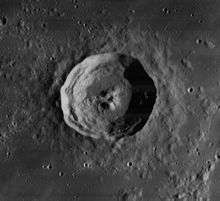 Lunar Orbiter 4 image | |
| Coordinates | 0.3°S 26.6°W |
|---|---|
| Diameter | 39 km |
| Depth | 3.1 km |
| Colongitude | 26° at sunrise |
| Eponym | Philippe van Lansberge |
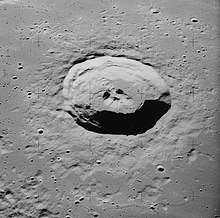
The crater is correctly spelled "Lansberg", but has sometimes been written "Landsberg" instead. It is named for the Belgian/Dutch astronomer Philippe van Lansberge.[1]
Approximately 40 km to the southeast of Lansberg is the landing site of the Luna 5 probe, and a further 60 km in the same direction is the landing site of Surveyor 3 and Apollo 12.[2]
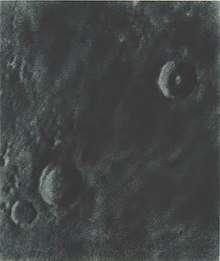
Satellite craters
By convention these features are identified on lunar maps by placing the letter on the side of the crater midpoint that is closest to Lansberg.
| Lansberg | Latitude | Longitude | Diameter |
|---|---|---|---|
| A | 0.2° N | 31.1° W | 9 km |
| B | 2.5° S | 28.1° W | 9 km |
| C | 1.5° S | 29.2° W | 17 km |
| D | 3.0° S | 30.6° W | 11 km |
| E | 1.8° S | 30.3° W | 6 km |
| F | 2.2° S | 30.7° W | 9 km |
| G | 0.6° S | 29.4° W | 10 km |
| L | 3.5° S | 26.4° W | 5 km |
| N | 1.9° S | 26.4° W | 4 km |
| P | 2.3° S | 23.0° W | 2 km |
| X | 1.2° N | 27.8° W | 3 km |
| Y | 0.7° N | 28.2° W | 4 km |
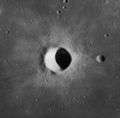 Lunar Orbiter 4 image of Lansberg A
Lunar Orbiter 4 image of Lansberg A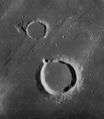 Lunar Orbiter 4 image of Lansberg C (larger, bottom) and Lansberg G (top)
Lunar Orbiter 4 image of Lansberg C (larger, bottom) and Lansberg G (top) Oblique view of Lansberg B (lower right), Lansberg D (upper left), and Lansberg F (upper right) from Apollo 14
Oblique view of Lansberg B (lower right), Lansberg D (upper left), and Lansberg F (upper right) from Apollo 14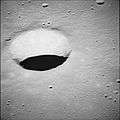 Closeup of Lansberg B from Apollo 14
Closeup of Lansberg B from Apollo 14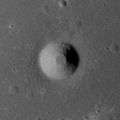
References
| Wikimedia Commons has media related to Lansberg (crater). |
- "Lansberg (crater)". Gazetteer of Planetary Nomenclature. USGS Astrogeology Research Program.
- Lunar and Planetary Institute, Digital Lunar Orbiter Photographic Atlas of the Moon, Photo Number IV-125-H3 (Annotated Lunar Orbiter 4 image)
- Andersson, L. E.; Whitaker, E. A. (1982). NASA Catalogue of Lunar Nomenclature. NASA RP-1097.CS1 maint: ref=harv (link)
- Bussey, B.; Spudis, P. (2004). The Clementine Atlas of the Moon. New York: Cambridge University Press. ISBN 978-0-521-81528-4.CS1 maint: ref=harv (link)
- Cocks, Elijah E.; Cocks, Josiah C. (1995). Who's Who on the Moon: A Biographical Dictionary of Lunar Nomenclature. Tudor Publishers. ISBN 978-0-936389-27-1.CS1 maint: ref=harv (link)
- McDowell, Jonathan (July 15, 2007). "Lunar Nomenclature". Jonathan's Space Report. Retrieved 2007-10-24.CS1 maint: ref=harv (link)
- Menzel, D. H.; Minnaert, M.; Levin, B.; Dollfus, A.; Bell, B. (1971). "Report on Lunar Nomenclature by the Working Group of Commission 17 of the IAU". Space Science Reviews. 12 (2): 136–186. Bibcode:1971SSRv...12..136M. doi:10.1007/BF00171763.CS1 maint: ref=harv (link)
- Moore, Patrick (2001). On the Moon. Sterling Publishing Co. ISBN 978-0-304-35469-6.CS1 maint: ref=harv (link)
- Price, Fred W. (1988). The Moon Observer's Handbook. Cambridge University Press. ISBN 978-0-521-33500-3.CS1 maint: ref=harv (link)
- Rükl, Antonín (1990). Atlas of the Moon. Kalmbach Books. ISBN 978-0-913135-17-4.CS1 maint: ref=harv (link)
- Webb, Rev. T. W. (1962). Celestial Objects for Common Telescopes (6th revised ed.). Dover. ISBN 978-0-486-20917-3.CS1 maint: ref=harv (link)
- Whitaker, Ewen A. (1999). Mapping and Naming the Moon. Cambridge University Press. ISBN 978-0-521-62248-6.CS1 maint: ref=harv (link)
- Wlasuk, Peter T. (2000). Observing the Moon. Springer. ISBN 978-1-85233-193-1.CS1 maint: ref=harv (link)
External links
- Oblique view of Lansberg at high sun angle from Apollo 12: AS12-51-7538